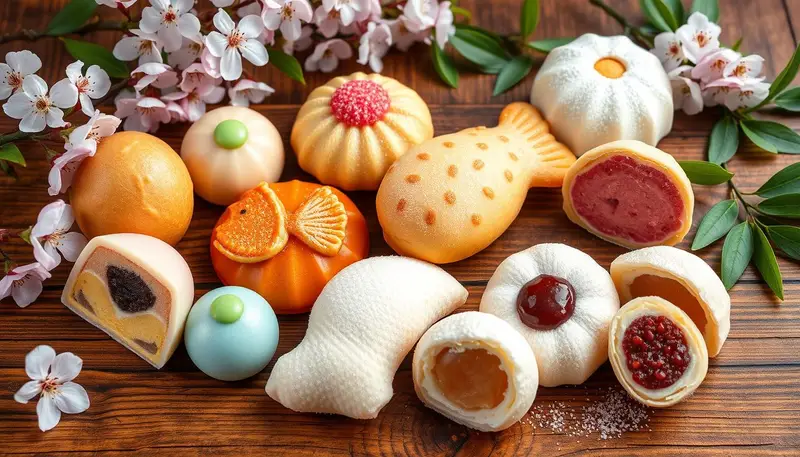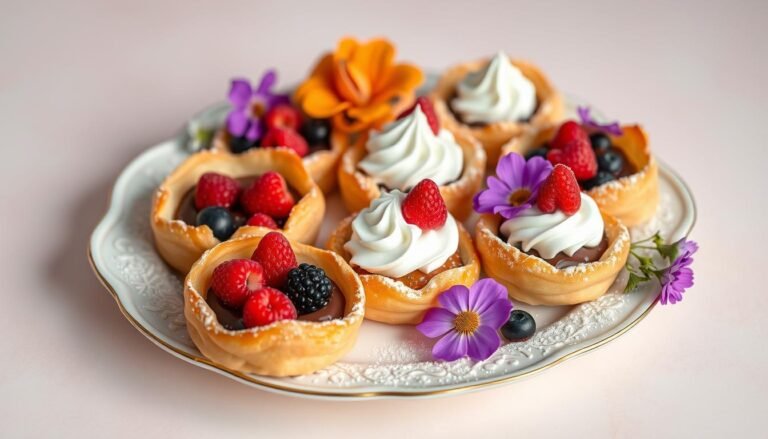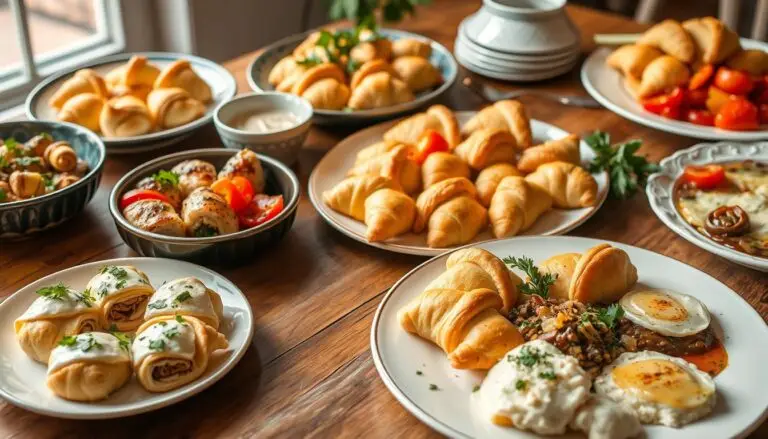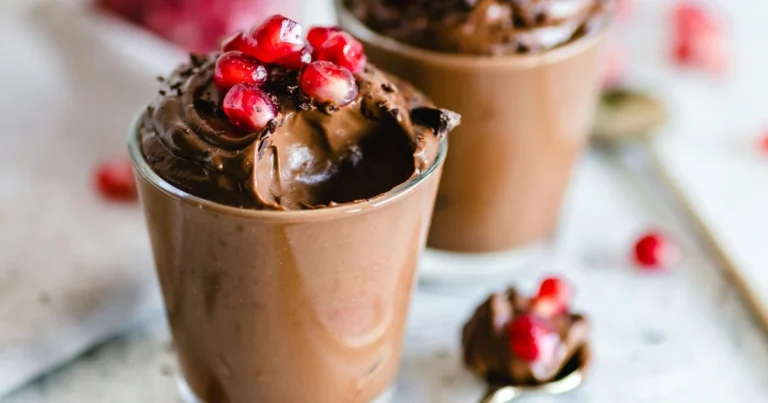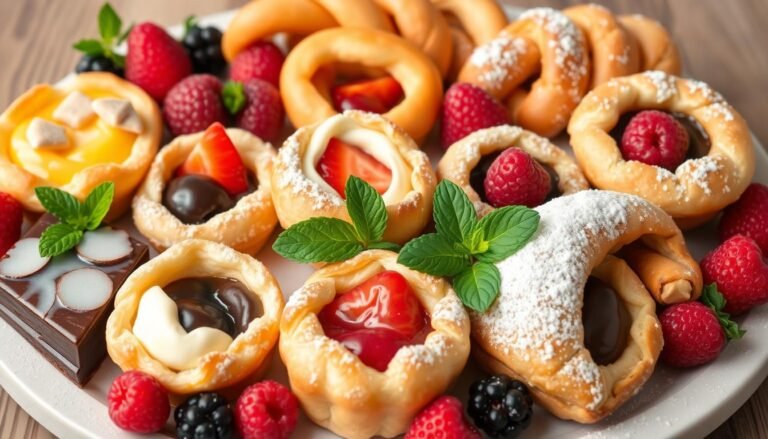Top Japanese Pastries You Need to Try: From Mochi to Taiyaki
Walking through Japan’s busy streets, I’m greeted by the enticing smells of fresh pastries. These scents lead me to explore the country’s rich dessert culture. From the soft mochi to the fun taiyaki, Japanese sweets are a mix of tradition and creativity.
Each piece is a journey of taste and beauty. It shows the care and skill that goes into every dessert. It’s a world where every bite is a celebration of tradition and innovation.
The variety of Japanese pastries shows the country’s love for its culture and openness to new ideas. As I try these treats, I learn about their history and the joy they bring. Whether you’re new to Japanese sweets or a fan, this adventure will excite your taste buds and deepen your appreciation for Japanese pastry art.
Melt 10 Pounds of Fat in a Week with This Green Smoothie>> Discover Now!
Table of Contents
Understanding Wagashi: Traditional Japanese Confectionery
Wagashi are exquisite traditional Japanese confections that have been cherished for centuries. They are often served with green tea, playing a key role in the Japanese tea ceremony. Wagashi’s origins date back to the 14th and 15th centuries, when they were first offered as religious gifts.
These desserts are shaped, colored, and made with ingredients that reflect the seasons and celebrations. For example, hanami dango, a springtime treat, captures the beauty of cherry blossoms. Each wagashi variety shows Japan’s love for nature and its seasonal rhythms.
The Cultural Significance of Tea Ceremonies
Tea ceremonies, known as chanoyu, are deeply connected with wagashi. These gatherings focus on high-quality green tea, with wagashi enhancing the experience. Wagashi not only nourish the body but also engage the senses, creating a peaceful atmosphere.
Historical Origins of Wagashi
The origins of wagashi date back to the 14th and 15th centuries. They were first introduced as offerings to the gods and Buddha. The introduction of sugar and tea cultivation led to the creation of new sweets in Japan. The Muromachi period saw the rise of simple wagashi served with tea ceremonies, solidifying their cultural importance.
Seasonal Influence on Wagashi Making
The changing seasons and celebrations deeply influence wagashi making. Artisans choose ingredients and designs that reflect the natural beauty and symbolic meanings of each season. Wagashi, from spring’s cherry blossom sweets to autumn’s red bean treats, embody Japan’s reverence for nature.
“Wagashi are not just desserts, but a reflection of the seasons and a celebration of Japanese culture.”
Essential Ingredients in Japanese Pastries
Japanese pastries are famous for their unique flavors. They use a mix of special ingredients. These include matcha, yuzu, and sweet potato, which blend together beautifully.
Matcha, the green tea powder, adds a special flavor and color to sweets. Mochigome, or glutinous rice, is used to make mochi and other treats. Azuki beans are turned into anko, a sweet paste, often mixed with sakura for a floral taste.
Yuzu fruit adds a zesty touch, while sakura petals give a floral hint. Sweet potatoes, especially Naruto Kintoki, are loved for their creamy texture and sweet taste.
“The harmonious blend of distinct flavors and textures is what truly sets Japanese pastries apart, making them a culinary delight for the senses.”
These ingredients, combined with Japanese confectionery skills, create delicious treats. They show off Japan’s rich food culture.
Exploring the Role of Anko and Mochigome
Anko, a sweet red bean paste, is key in many Japanese sweets. It’s found in taiyaki, sakuramochi, and dorayaki. It’s paired with mochigome, or glutinous rice, for a unique texture.
Mochigome is vital for making mochi, a favorite Japanese rice cake. To make mochi, rice is pounded until it’s sticky. Then, it’s shaped into round or rectangular forms.
Mochi: Japan’s Beloved Rice Cake Delicacy
Mochi, a traditional Japanese rice cake, has been loved for over a thousand years. It’s made from special glutinous rice and filled with sweet treats like red bean paste, ice cream, or fresh fruit. These soft, chewy treats are a big part of Japan’s food culture.
Different Types of Mochi Fillings
Mochi is known for its many fillings. You can find daifuku with sweet red bean paste or ichigo daifuku with fresh strawberry. For something new, try mochi ice cream with flavors like matcha, strawberry, and mango.
Traditional Mochi-Making Process
Making mochi the old way is called mochitsuki. It involves pounding rice with wooden mallets, showing community and strength. Even with electric machines, many still do it together, especially at New Year’s.
Popular Mochi Variations
- Kusa Mochi: A green mochi made with mugwort or Japanese parsley, enjoyed on March 3.
- Sakura Mochi: A pink mochi wrapped in pickled cherry blossom leaves, a spring treat.
- Warabi Mochi: A jelly-like mochi from bracken fern, loved in summer.
Mochi has grown from sacred to everyday, becoming a key part of Japanese culture. It brings a taste of tradition with every bite.
Sweet Red Bean Paste: The Heart of Japanese Sweets
Sweet red bean paste, known as anko, is a key ingredient in many Japanese desserts. It’s made from azuki beans and sugar. This paste comes in different textures, each with its own taste.
The main types of anko are tsubuan (whole beans), koshian (smooth paste), and ogura-an (a mix of whole and mashed beans). There’s also tsubushian (partially mashed) and sarashian (from dried beans). These are used in favorites like dorayaki, taiyaki, and wagashi sweets.
The flavor of anko is rich and subtly sweet. It’s a must-have in Japanese cooking. From sakura-an (cherry blossom paste) to kurogoma (black sesame paste), anko shows the skill of Japanese pastry making.
anko is enjoyed in many ways, like in zunda (mashed edamame with anko) or in daifuku mochi. It’s a beloved part of Japan’s food culture. From old traditions to new creations, anko always impresses.
Popular Japanese Pastries You Can’t Miss
Japan is famous for its wide range of traditional pastries. Each pastry has its own history and cultural importance. The dorayaki, taiyaki, and imagawayaki are among the most loved Japanese sweets.
Dorayaki: The Classic Bean-Filled Pancake
Dorayaki is a key part of Japanese street food. It has two soft pancakes with sweet red bean paste, or anko, in between. This pastry shows how anko-filled pastries are a big part of Japanese sweets.
Taiyaki: Fish-Shaped Sweet Treats
Taiyaki are pastries shaped like a Japanese sea bream fish. They are filled with anko, but can also have custard, chocolate, or other sweet fillings. Their fish shape and different flavors make them a fun choice for fans of dorayaki and imagawayaki.
Imagawayaki: Circular Sweet Delights
Imagawayaki, also called obanyaki, are round, griddle-caked anko-filled pastries loved in Japan. They can be filled with anko, custard, or seasonal treats. Their easy-to-eat shape and variety of fillings make them a favorite Japanese street food.
“The artistry and attention to detail in Japanese pastries is truly remarkable, showcasing the rich culinary heritage and unwavering commitment to quality that define the nation’s food culture.”
Seasonal and Festival Japanese Desserts
Japanese desserts change with the seasons and celebrate the country’s culture. The sakuramochi is a sweet treat with cherry blossom flavor. It’s enjoyed during spring’s flower-viewing parties.
As the year goes on, new desserts come out. In May, families enjoy kashiwa mochi with its oak leaf wrapping. All year, wagashi designs change to show off each season’s beauty.
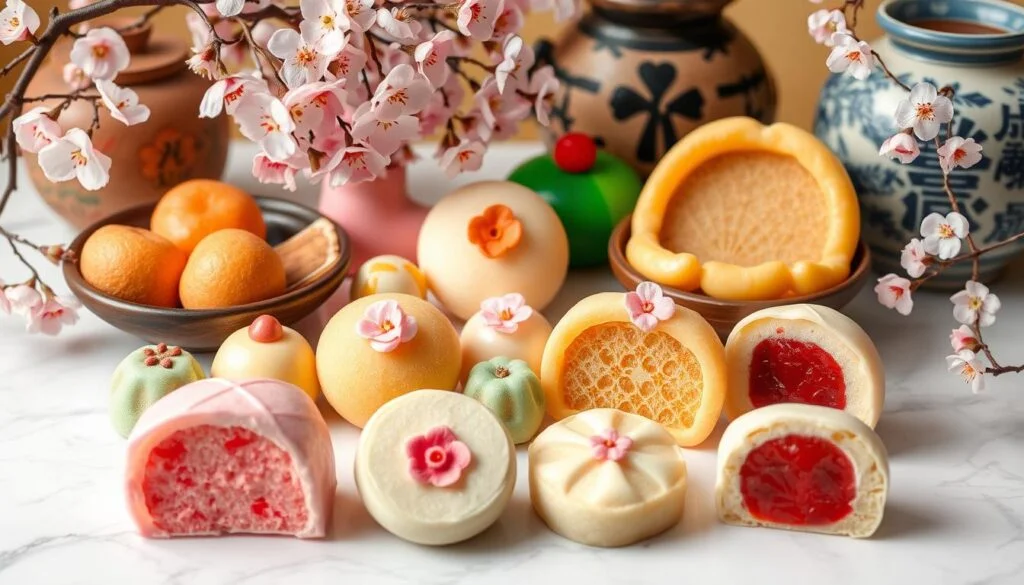
Melt 10 Pounds of Fat in a Week with This Green Smoothie>> Discover Now!
These desserts are more than just food. They show Japan’s cultural traditions. Thhttps://go.smoothiediet.com/?&shield=89398gyitccsevem1cxdq6ka2h&traffic_source=thecozyrecipesey’re a big part of celebrations, from tea ceremonies to ancient festivals. They keep Japanese culinary art alive.
| Seasonal Dessert | Description | Festival Association |
|---|---|---|
| Sakuramochi | A delicate rice cake filled with sweet red bean paste and wrapped in a salted cherry blossom leaf. | Celebrated during the spring cherry blossom season. |
| Hanami Dango | A trio of small, colorful rice dumplings in pink, white, and green, served during spring flower-viewing parties. | Enjoyed during the Hanami (flower-viewing) festival. |
| Kashiwa Mochi | A sweet rice cake filled with red bean paste and wrapped in an oak leaf, typically served during Children’s Day in May. | Part of the Tango no Sekku (Children’s Day) celebrations. |
These desserts are a treat for the senses. They offer a peek into Japan’s rich culture. They’re a must-try for anyone who loves Japanese food.
Modern Innovations in Japanese Pastry Making
In the world of Japanese pastry, old meets new. Chefs are mixing classic methods with new tastes and looks. They create amazing matcha-infused pastries, tasty Japanese cheesecake, and fluffy soufflé pancakes. The modern Japanese pastry scene is a treat for the senses.
Fusion Flavors and Contemporary Twists
Traditional Japanese ingredients meet Western desserts in a new way. Matcha, a green tea powder, is now in cakes, cookies, and ice cream. It brings a sweet and earthy taste together. Japanese cheesecake, light and airy, has become a hit worldwide, offering a fresh twist on a classic.
Instagram-Worthy Pastry Trends
Today, desserts need to look as good as they taste. Japanese pastry chefs have stepped up, making Instagram-worthy desserts that are both beautiful and true to Japanese sweets. They create stunning latte art and colorful treats that please the eyes and taste buds.
“The key to the modern Japanese pastry revolution lies in the seamless fusion of time-honored techniques and contemporary flair, resulting in a culinary experience that is both deeply rooted in tradition and utterly innovative.”
Where to Find the Best Japanese Pastries
Japanese pastries, from traditional wagashi to modern fusion, are found across the country. You can find them in Tokyo, Kyoto, Osaka, and the countryside. There’s plenty of places to try these tasty treats.
For a true Japanese pastry experience, visit wagashi shops. These places are filled with skilled artisans making these old-time treats. They offer a calm, authentic setting where you can enjoy the flavors and learn about their cultural importance.
In cities, look for Japanese bakeries and dessert shops. They mix traditional and modern pastries. You might find unique creations that blend Japanese tastes with Western styles. LeTao in Hokkaido is famous for their cheesecakes and dairy treats.
Don’t miss the konbini, or Japanese convenience stores. They have a surprising range of Japanese pastries and desserts. They’re perfect for a quick sweet fix while you’re out.
For a deeper experience, check out food markets and local shopping districts. Here, you can find hidden pastry shops. They might have special treats you can’t find anywhere else.
The best way to find the best Japanese pastries is to explore. Use local food guides and online reviews. Be open to trying new places. With a curious mind and a good taste, you’ll have a great time discovering new flavors.
The Art of Japanese Pastry Presentation
In Japan, the art of pastry presentation is as vital as the flavors. Wagashi, the traditional Japanese sweets, are made to look like natural objects or seasonal motifs. This shows Japan’s deep love for food aesthetics. The packaging and gifting of these sweets are also key in Japanese gift-giving culture.
Many Japanese pastries are made to be beautiful, not just tasty. They reflect Japan’s respect for wagashi artistry and the beauty in everyday life. The designs and details of these treats aim to capture the essence of the seasons and nature.
The seasonal presentation of Japanese pastries is a feast for the eyes. From matcha sweets to sakura blossoms on mochi, they are stunning. They come in elegant, simple packaging, making them perfect gifts for any time.
“The art of Japanese pastry presentation is a harmonious blend of flavor, texture, and visual elegance, captivating the senses and elevating the overall dining experience.”
Enjoying a slice of Japanese cheesecake or a taiyaki is a treat for the senses. The focus on detail and beauty makes Japanese pastries unique. They are truly works of art.
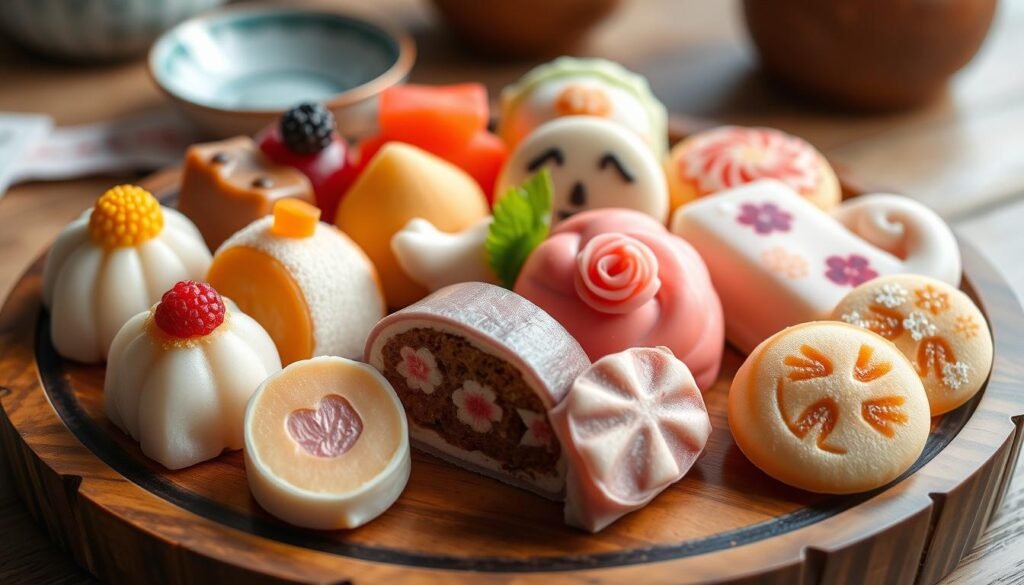
Health Benefits and Nutritional Aspects
Traditional Japanese pastries, known as wagashi, are good for you. They have natural ingredients and less sugar than Western sweets. Ingredients like matcha, azuki beans, and agar add nutrients and antioxidants.
Matcha, a green tea powder, is full of antioxidants. It helps protect the body. Azuki beans are in many wagashi. They are rich in dietary fiber, protein, and vitamins.
Agar, from seaweed, is almost calorie-free. It’s also full of dietary fiber. This helps control fat and sugar absorption.
| Pastry | Calories (per 100g) | Protein (g) | Fat (g) | Carbs (g) | Dietary Fiber (g) |
|---|---|---|---|---|---|
| Daifuku Mochi | 235 | 4.8 | 0.5 | 52.8 | 2.5 |
| Steamed Yokan | 242 | 4.4 | 0.3 | 55.4 | 2.9 |
| Dorayaki | 284 | 6.6 | 4.4 | 81.0 | 3.1 |
Eating wagashi with green tea boosts antioxidants. It also helps control blood sugar and aids digestion. These treats are healthier than Western sweets because of their natural ingredients and smaller sizes.
“Wagashi are not only delicious, but they also offer a range of health benefits due to their natural ingredients and thoughtful preparation.”
Exploring Regional Japanese Pastry Specialties
Japan’s diverse culinary landscape is seen in its many pastry specialties. From Hokkaido’s dairy-rich treats to Kyoto’s traditional sweets, and Tokyo’s modern desserts, each area shows off local flavors and traditions.
Hokkaido’s Dairy-Based Treats
Hokkaido is famous for its high-quality dairy farms. It’s known for its regional specialties made with Hokkaido milk. Try creamy Hokkaido-style pastries and rich Hokkaido-style soft serve ice cream. These desserts show Hokkaido’s skill in dairy-based sweets.
Kyoto’s Traditional Confections
Kyoto, the ancient capital, is full of Kyoto wagashi. These traditional sweets have been perfected over centuries. They’re inspired by nature and the seasons, perfect for tea ceremonies. Enjoy the delicate flavors and designs of Kyoto’s wagashi masters, each a piece of edible art.
Tokyo’s Modern Pastry Scene
Tokyo, Japan’s busy capital, leads in dessert trends. Its pastry chefs mix classic methods with new, bold flavors. They create stunning treats that are perfect for Instagram. Discover the city’s exciting pastry scene, from unique cakes to Tokyo-style doughnuts, and see how Japanese desserts are evolving.
“Exploring Japan’s regional pastry specialties provides a fascinating glimpse into the diverse culinary traditions and cultural identities that shape the country’s unique dessert landscape.”
Conclusion
Japanese pastries offer a special culinary journey. They mix old techniques with new ideas. From mochi’s chewy texture to wagashi’s delicate tastes, they show Japan’s rich tradition and care for detail.
As more people around the world try them, Japanese pastries keep getting better. They now offer both classic treats and fresh, exciting flavors for everyone.
Exploring Japanese pastries is more than just trying desserts. It’s a journey into Japan’s culture and traditions. These sweets not only please your taste buds but also highlight Japan’s love for nature and its skilled bakers.
As you explore Japanese pastries, enjoy their rich history, new flavors, and beautiful presentation. Dive into the mix of old and new, and let these sweets take you to Japan’s culinary heart.

